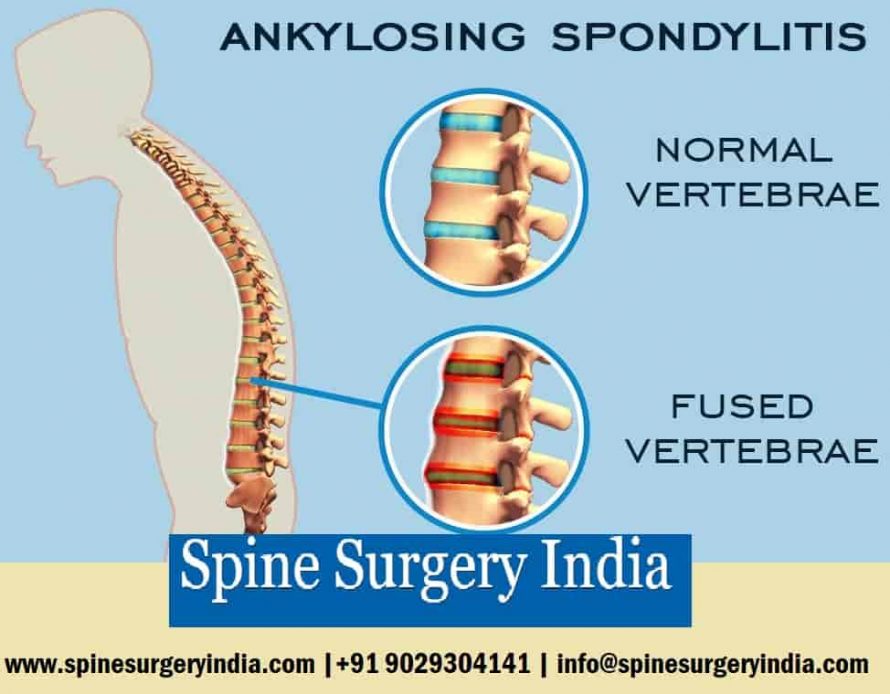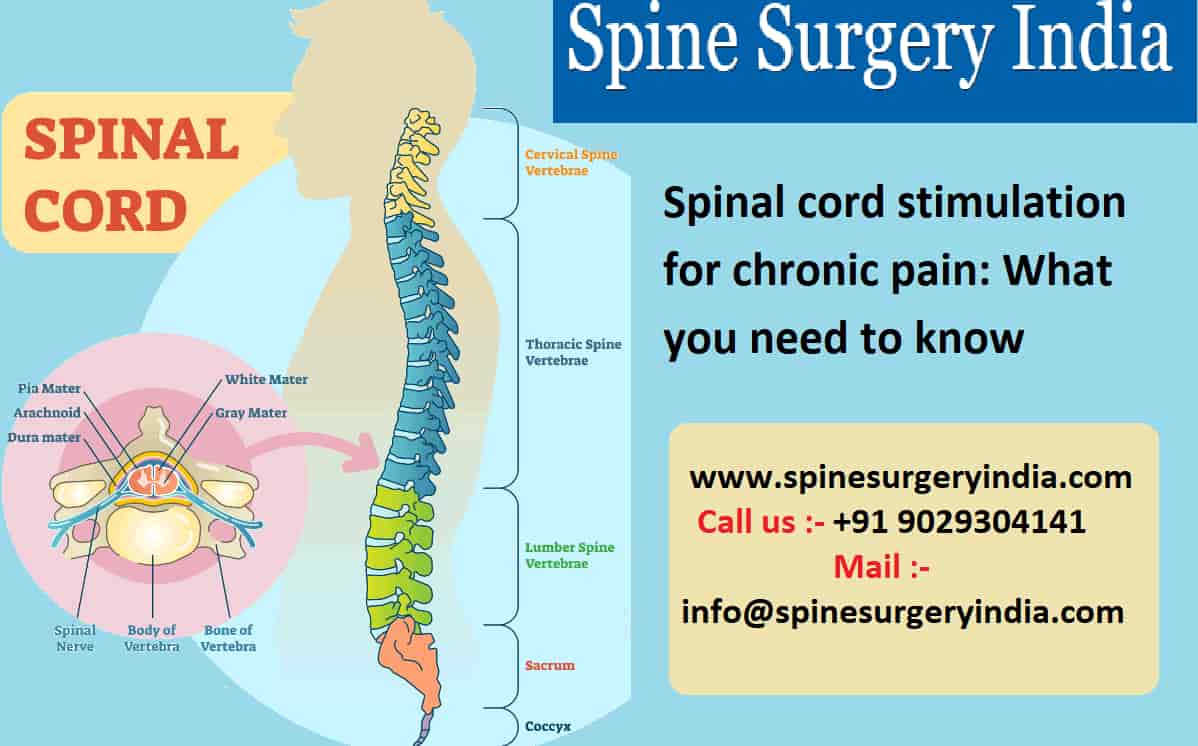
Ankylosing Spondylitis in India is a chronic inflammatory disease. It is a form of arthritis which affects your spine and hip joints. The spinal joints of your spine are known as vertebrae and these joints get inflamed when Ankylosing Spondylitis occurs which leads to discomfort, severe and chronic pain. In severe cases, there can be a chance where a formation of new bone develops which makes your spine fused up. You may present a forward-stopped position or you will get immobile. This stopped position is referred to as kyphosis in medical terminologies.
Is there any chance that Ankylosing Spondylitis affects other parts of the body?
Yes, Ankylosing spondylitis is a disease which can affect your other parts of the body and can also cause stiffness, inflammation, and pain in other parts of the body such as it can affect your shoulders, ribs, hips, heels, and smaller joints of hands and foot. There are very few cases where your eyes may also be affected.
Cause of ankylosing spondylitis
The surgeons at Spine Surgery India say that the cause of Ankylosing spondylitis is unknown; however, the presence of the HLA-B27 gene is identified which is a possible cause. According to the study, there are about 90% of people with Ankylosing spondylitis are positive for the HLA-B27 marker. However, there is only 10% of HLA-B27-positive individuals ever develop Ankylosing spondylitis or a related disease. If an HLA-B27-positive person has a family member who is suffering from Ankylosing spondylitis disease then that person’s risk of developing spondylitis is significantly higher than that of other HLA-B27-positive people. Individuals with this gene may suffer from Ankylosing spondyloarthritis and enteropathic arthritis. According to some researchers, there can be a chance of infection which may trigger Ankylosing spondylitis in those who are genetically susceptible, however, this theory is still under research and difficult to confirm.
Symptoms of ankylosing spondylitis
The following are the most common symptoms that have been reported by the people who suffered from Ankylosing Spondylitis disease and this includes:
- Intensive and continuous pain in the lower back.
- The people experience excessive coughing.
- The people who suffered from Ankylosing Spondylitis deals with fatigue and loss of appetite.
- Forwardly stopped position.
- They experience pain in their joints after vigorous physical activity.
- They feel inflammation sensation near the tendons and ligament.
How the surgeons diagnose Ankylosing Spondylitis disease?
To diagnose Ankylosing Spondylitis disease your surgeon will perform a basic physical examination where he/she may ask you to bend your back in different ways. Your surgeon will then check your chest circumference and also search for pain points by pressing on specific portions of your pelvis or by moving your legs into a particular position. After that, your surgeon might ask you to try to stand upright, with your heels and the back of your head against a wall.
Following the diagnoses, your surgeon may suggest you with following tests and scans to see what further treatments need to be taken into consideration to treat Ankylosing Spondylitis disease:
- Imaging tests: Your surgeon will perform X-rays which allow them to check for changes in your joints and bones. Also, they conduct an MRI scan which is used to provide more detailed images of your bones and soft tissues. With the help of MRI scans, your surgeon will get to know about ankylosing spondylitis in an earlier stage, however, MRI scans are much more expensive than X-rays.
- Blood or Lab tests: To identify ankylosing spondylitis, there are no such specific lab tests, however, your surgeon will suggest certain blood tests through which they can check for markers of inflammation, but inflammation can be caused by several other health problems. Your surgeon will conduct a blood test for the HLA-B27 gene; however, it has been found that most of the people who have that gene don’t have ankylosing spondylitis.
Treatments for Ankylosing spondylitis disease in India
As there are no specific treatments are available to treat Ankylosing spondylitis disease, but the goals of the following treatments include reducing the discomfort, stiffness, and pain. These treatments are:
a) Physical therapy: The physical therapy is one of the best and suitable treatments to retain or maintain the physical function also it helps in reducing the deformity.
b) Drugs: Your surgeon will prescribe some drugs which provide relief from the pain and help you to resume your daily activities without any discomfort. The drugs like NSAIDs, disease–modifying anti-rheumatoid drugs, steroid injections, and antidepressants will be generally prescribed by the surgeons at Spine Surgery India.
c) Exercise: Your surgeon will advise you to perform regular exercises which help in treating the stiffness in your body and also strengthen your muscles. With the help of regular exercises, the risk of disability will be reduced. Generally, the surgeons at Spine Surgery India recommend swimming as the best exercise which works well for people with Ankylosing Spondylitis.
d) Surgery: The spine surgeons suggest the surgery to the patients as the last option when other treatments were failed to provide relief from Ankylosing spondylitis disease. Your surgeon will only recommend surgery if you have severe discomfort due to joint damage.
What lifestyle needs to follow for Ankylosing spondylitis?
You need to follow the below instructions prescribed by your surgeon to get rid of Ankylosing spondylitis disease and these are:
- Your surgeon will recommend you to sit on the chairs that don’t let you steep your posture.
- Your surgeon will suggest avoiding pillows and beneath the neck while resting.
- Your surgeon will ask you to quit smoking and other tobacco products as it aggravates the condition.
- They will suggest you sleep on a mattress which keeps your back straight.
What diet do you need to follow for Ankylosing spondylitis?
You need to consume the diet which contains Omega-3 fatty acids that are available in cold water fishes such as salmon, tuna, etc. are beneficial. You can also take flax seeds and walnuts which reduce the disease activities. The people who are dealing with Ankylosing spondylitis for them a healthy diet improve the symptoms and reduce the disease progressing activity.
Related posts
Jan06
May31
Apr13
Apr25



















